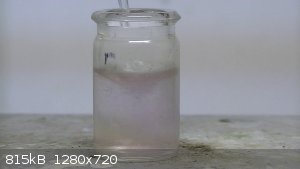fluorescence
Hazard to Others
  
Posts: 285
Registered: 11-11-2013
Member Is Offline
Mood: So cold outside
|
|
Os Peroxo compound (red) ?
Good evening,
On my way through the PSE, I stopped at Os now. And although I wanted to upload all the Os videos on youtube already I am still stuck. The reason is
that I only have a solid lump of Os metal. I checked the very first original literature and most of the things only work with powdered Os. I tried
everything but it wouldn't dissolve till I came up with a quite good solution that etches Os slowly to form OsO4. At the rate this works, however, I
get like 10 ml per every 3 or 4 weeks and then although the solution is deep yellow the conc. should be fairly low. I already witnessed this when
working with it. I cannot really dilute it or it will become nearly colorless. So most stuff has to be done in a conc. solution to stay visible. Thank
god Os forms low spin complexes so I still get some intensity back even at the higher dilution.
Now on my way through the various books, I found a line that mentioned a red complex when OsO4 reacts with H2O2 in
KOH. It didn't say what formed though.
I tried it and I also add a picture here. It is hard to see the red color but this is due to the fact that this is a very high dilution and only 3%
H2O2 and that there is still a lot of my reagent in the OsO4 which destroys H2O2 quite fast. So
the complex only lasts for a few milliseconds before falling apart. Nonetheless, it became red for a short moment.
The problem is however that Os actually catalyzes the decomposition of H2O2 and at least according to my latest books from 2013
there are no peroxy-complexes of Osmium. The old literature did not mention a decomposition of the red complex though so I believe it has to be
something I just don't know what...
Osmium has two different favored oxidation states depending on whether you work in acid or in base and high base conc. are said to form a red complex,
too, so perhaps the H2O2 reduces the Osmium and helps to form the red complex faster. But then the color should last and the
cool thing is as soon as the H2O2 is destroyed by either the Os or my secondary reagent it will turn yellow again. If I add more
it turns red again. I'd understand if it turned yellow once I add H2O2 and the hydroxo-complex is oxidized but this is the other
way around...at least it looks like that....
I can't find much on that topic unfortunately but perhaps somebody has an idea what it is. I've been trying to make different Os complex for a couple
of months now (mostly I am limited by the trace amounts of OsO4 I am getting) and I'd say 90% of the reactions do not work as planned.
Still, some of it worked well. And I never managed to make the red basic complex before so I cannot tell if the colors match and this red formed here
might perhaps be the hydroxo-complex.
Perhaps someone of you guys has an idea.

|
|
|
Dan Vizine
National Hazard
   
Posts: 628
Registered: 4-4-2014
Location: Tonawanda, New York
Member Is Offline
Mood: High Resistance
|
|
Well, I think that you already touched on your first step. You need to make some of the osmate K2OsO4(OH)2 for comparison of properties. It is very
confusing why osmium tetroxide (apparently) would not stay in the form of the osmate in basic solution. As you mentioned, it would've been expected to
stay red regardless of what the dilute peroxide was doing, and especially once the peroxide was gone.
"All Your Children Are Poor Unfortunate Victims of Lies You Believe, a Plague Upon Your Ignorance that Keeps the Youth from the Truth They
Deserve"...F. Zappa
|
|
|
fluorescence
Hazard to Others
  
Posts: 285
Registered: 11-11-2013
Member Is Offline
Mood: So cold outside
|
|
Ah, I found it. Although I am not sure what their final conclusion now is. Is it an Os(VII)-Superoxide that causes the red color or a shift between
Os(VIII) and Os(VI) now?
So from my understanding what they think is the following:
As OsO4 does not really react with H2O as nucleophile (well this is not true, it does hydrolyze to some extent) but will react
with OH- as nucleophile they assume, as H2O2 and NaOH form HO2- which is an even stronger
nucleophile it will react to form a similar Os(VIII)-O2H complex. And this will react to Os(VI) and H2O. According to the redox
potentials for H2O2 it will form H2O and O2 and 2e-. But usually, electron transfers are always
SET processes sometimes very fast ones which appear to be two-electron transfers. So in between, especially with O2-Systems being some very
good so called non-innocent ligands an Os(VII)-Superoxide(radical) is likely.
And they just say that this might be easier to excite and therefore shift towards red. For the yellow in the end it might just be spare Os(VIII) in
solution for me as Os(VI) is I think nearly colorless to yellow in aqueous solution (blue in alcohols) and the red color is more intense you might be
able to see traces of the OsO4 afterwards. Or rests of my oxidizer which is still in solution oxidize it back to VIII.
Attachment: csnyi1986.pdf (209kB)
This file has been downloaded 237 times
[Edited on 25-5-2017 by fluorescence]
[Edited on 25-5-2017 by fluorescence]
|
|
|